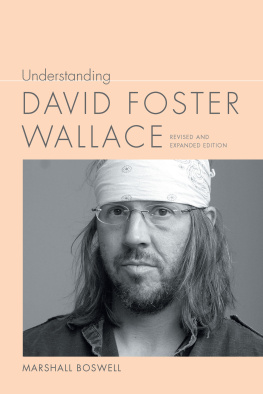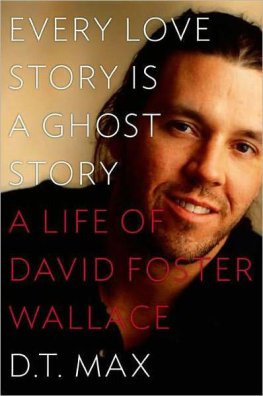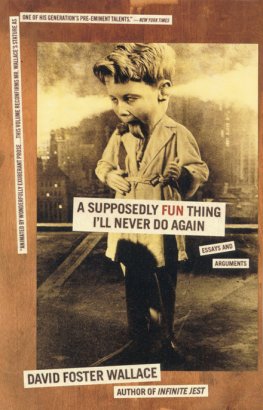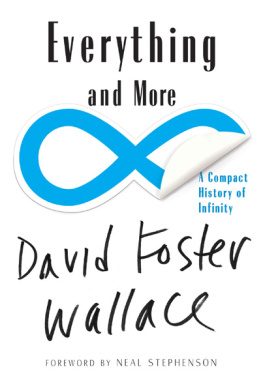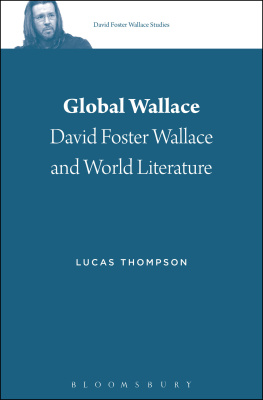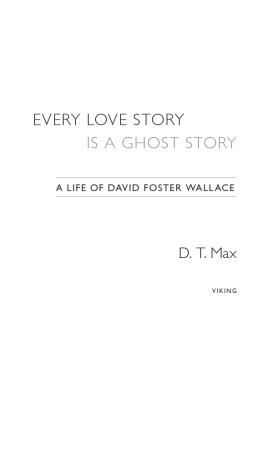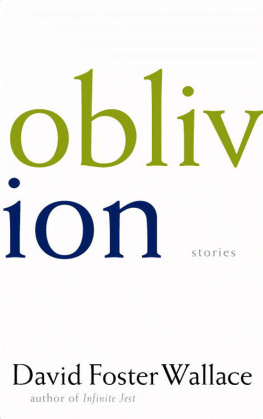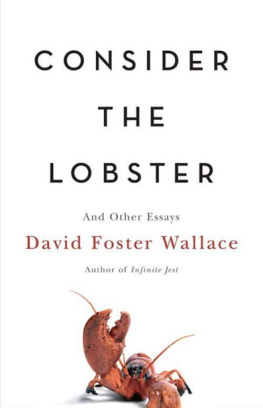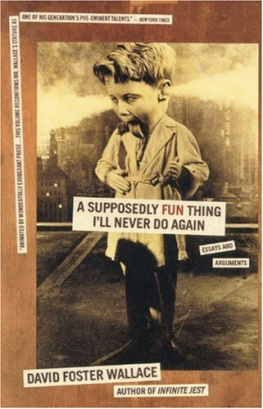Marshall Boswell - The Wallace Effect: David Foster Wallace and the Contemporary Literary Imagination
Here you can read online Marshall Boswell - The Wallace Effect: David Foster Wallace and the Contemporary Literary Imagination full text of the book (entire story) in english for free. Download pdf and epub, get meaning, cover and reviews about this ebook. year: 2019, publisher: Bloomsbury Academic, genre: Detective and thriller. Description of the work, (preface) as well as reviews are available. Best literature library LitArk.com created for fans of good reading and offers a wide selection of genres:
Romance novel
Science fiction
Adventure
Detective
Science
History
Home and family
Prose
Art
Politics
Computer
Non-fiction
Religion
Business
Children
Humor
Choose a favorite category and find really read worthwhile books. Enjoy immersion in the world of imagination, feel the emotions of the characters or learn something new for yourself, make an fascinating discovery.

- Book:The Wallace Effect: David Foster Wallace and the Contemporary Literary Imagination
- Author:
- Publisher:Bloomsbury Academic
- Genre:
- Year:2019
- Rating:5 / 5
- Favourites:Add to favourites
- Your mark:
- 100
- 1
- 2
- 3
- 4
- 5
The Wallace Effect: David Foster Wallace and the Contemporary Literary Imagination: summary, description and annotation
We offer to read an annotation, description, summary or preface (depends on what the author of the book "The Wallace Effect: David Foster Wallace and the Contemporary Literary Imagination" wrote himself). If you haven't found the necessary information about the book — write in the comments, we will try to find it.
The Wallace Effect: David Foster Wallace and the Contemporary Literary Imagination — read online for free the complete book (whole text) full work
Below is the text of the book, divided by pages. System saving the place of the last page read, allows you to conveniently read the book "The Wallace Effect: David Foster Wallace and the Contemporary Literary Imagination" online for free, without having to search again every time where you left off. Put a bookmark, and you can go to the page where you finished reading at any time.
Font size:
Interval:
Bookmark:

The Wallace Effect
for Rebecca
DAVID FOSTER WALLACE STUDIES
Vol. 2
Series Editor
Stephen J. Burn, University of Glasgow, UK
Advisory Board
Kasia Boddy, University of Cambridge, UK
Marshal Boswell, Rhodes College, USA
Paul Giles, University of Sydney, Australia
Luc Herman, University of Antwerp, Belgium
Mary K. Holland, The State University of New York at New Paltz, USA
Steven Moore, Independent Scholar, USA
Volumes in the Series
Vol. 1. Global Wallace
Lucas Thompson
Vol. 2. The Wallace Effect
Marshall Boswell
Vol. 3. Wallaces Dialects (forthcoming)
Mary Shapiro

CONTENTS
The first volume in this seriesLucas Thompsons Global Wallaceoffered an intensive study of Wallaces works, picking apart the texture of his intricately crafted oeuvre to reveal their often overlooked borrowings from, and allusions to, the corpus of world literature. The second volume in this serieswhich you are now holding in your handsreverses this approach and, instead of tracing the recurrence of other works and writers within Wallaces texts, maps the place of his fiction in the wider field of contemporary American literature. Yet, despite their different angles of approach, both studies seek to enlarge our map of the literary world within which Wallace wrote. If Thompsons volume provided a timely corrective to the provincial impulse to confine a reading within American borders, then Marshall Boswells study challenges the widespread tendency for Wallace studies to treat Wallaces work as sui generis within those borders, by deepening our sense of the context out of which Wallace wrote, and by measuring the sometimes ambivalent impact Wallace had on other writers, which Boswell calls the Wallace Effect.
The fact of Wallaces influence on contemporary literature is, by now, well established and widely noted. Jeffrey Severs, for instance, begins his excellent study of value in Wallaces work by arguing that his fiction signalled a sharp turn against postmodernist tenets and galvanized a new phase in contemporary global literature (1). Yet what is often overlooked is the extent to which that influence has overspilled the boundaries of any particular type of fiction. The experimental edge of his output, and his early sympathies for extreme avant-garde shit (Conversations 71), help account for his appeal to innovative writers at independent presses whose work abandons the codes and comforts of the well-made realist novel. Bennett Sims, for instance, dedicates his virtuosic reformulation of the zombie novel, A Questionable Shape (2013), to Wallace and bends his signature footnotes to match the books content (the footnote digs a grave in the text, an underworld in the text [16n1]). Similarly, Evan Lavender-Smiths From Old Notebooks (2010) adopts the style of David Marksons late works and periodically punctuates its atomistic structure with ideas about and reflections upon Wallaces fiction:
Essay describing the structure of Infinite Jest as Hofstadterish strange loop, the novels structure being that of a circle with a missing section. (15)
David Foster Wallace is at his very best when he transforms the temperature of a particular mode of language from cold to warm. (114)
At the same time, it is equally common to find Wallace namechecked in more mainstream works. Thus, in Paul Beattys prizewinning The Sellout (2015), Foy Cheshire casually announces that his reimagined multicultural text, Of Rice and Yen, will put him in the company of Virginia Woolf, Kawabata, Mishima, Mayakovsky, and DFW (253).
Such references do not, of course, automatically indicate a uniformly detailed engagement with Wallaces legacy andin some instancesmore accurately reflect the way Wallaces name has become a floating signifier for variously amorphous cultural yearnings. Beattys namecheck is notable in this respect, inasmuch as he uses the quasi-brand name DFW rather than anything more personal and submerges his name in a list whose unity comes not from any shared style but from these writers fame as suffering artists. While it is no doubt significant that Beattys list reaches beyond the common canon of white tortured artistsKawabata rather than Plath; Mishima rather than Hemingwayand while The Sellouts book-length meditation on what happens to individual identity when everything about identity is subjected to relentless satire is not entirely divorced from Wallaces own concerns, two salient points emerge from such examples. The first is that the mere invocation of a name offers insufficient grounds for documenting the extent of Wallaces relevance to a text; the second is that Wallaces biography mingles with his literary achievements as contemporary fictions come to terms with his legacy.
Marshall Boswells The Wallace Effect is the first full-length study of Wallaces impact on American letters, and it is decisively attuned to such complexities that emerge from his legacy. In terms of the breadth of Wallaces influence, the book offers the fullest studies to date of two of the key figuresJonathan Franzen and Jeffrey Eugenideswho are most often associated with Wallace in that sharp turn against postmodernist tenets. But it also looks beyond those writers who were sufficiently indebted to postmodernism for a turn to be necessary, by addressing Wallaces place in Claire Messuds realist fiction, andin a chapter partly devoted to Lauren Groffchallenging the male-centric model of literary achievement that is regularly invoked to measure Wallaces work. In addressing this cast of authors, Boswells study zeroes in on the question of when and where Wallaces influence can reasonably be attributed and is especially alert to those instances where an author explicitly denies Wallaces ghostly appearance in their text. Across the whole book, these studies come together to document the way that these spectral appearances construct Wallace as a composite figure, partly assembled from the signature obsessions that run through his texts, but also drawing freely on his biography.
Boswells readings are eclectic and typically comprehensive, but they also open the door for readers to move outside his shortlist of novels and pursue further iterations of the Wallace Effect. After reading Boswells detailed account of the way Franzen diffuses Wallace trademarks throughout Freedom, the significance of Franzens persistent, yet apparently more subdued, allusions in Purity (2015) merit further attention: in a book rife with allusions to Hamlet, Tom Aberant almost echoes Wallaces assignment to follow John McCain for Rolling Stone when he passes up an opportunity to follow the Dukakis campaign for Rolling Stone (409), while Anabel reprises one of the movies from James Incandenzas filmography in Infinite Jest (Every Inch of Disney Leith [989n24]) via her plan to divide her body into a grid of 32-square-centimeter cuts that will each be individually filmed (401). Similarly, in light of Boswells exploration of how the Wallace Effect registers an unmistakable strain of sexual menace, the fact that Jennifer Egans parody of Wallaces style in A Visit from the Goon Squad is also an explicit study of sexual menace may merit further examination.
Yet as The Wallace Effect points forward to later novels, it alsocruciallydirects its gaze sideways and backward. In much Wallace criticism, postmodernist tenets are confined to an imaginary past, where they are archived as historical, immutable facts. Following Wallaces own cues, John Barth, in particular, is forever locked in 1968 and denied the considerable artistic development that followed his landmark, yet arguably not-especially representative, achievements in
Font size:
Interval:
Bookmark:
Similar books «The Wallace Effect: David Foster Wallace and the Contemporary Literary Imagination»
Look at similar books to The Wallace Effect: David Foster Wallace and the Contemporary Literary Imagination. We have selected literature similar in name and meaning in the hope of providing readers with more options to find new, interesting, not yet read works.
Discussion, reviews of the book The Wallace Effect: David Foster Wallace and the Contemporary Literary Imagination and just readers' own opinions. Leave your comments, write what you think about the work, its meaning or the main characters. Specify what exactly you liked and what you didn't like, and why you think so.

